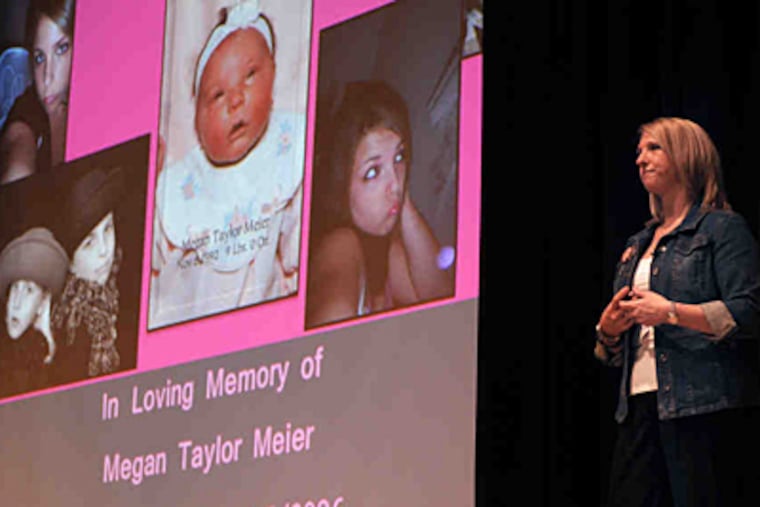Parents, students learn about cyberbullying and its sometimes-deadly results
Tina Meier's eldest daughter, Megan, would have been 18 had she not hanged herself five years ago, when a "boy" she had become friendly with on a social-networking site suddenly turned on her with vicious comments.

Tina Meier's eldest daughter, Megan, would have been 18 had she not hanged herself five years ago, when a "boy" she had become friendly with on a social-networking site suddenly turned on her with vicious comments.
The boy was a hoax, the creation of a neighborhood mother and daughter and another girl. Megan's parents did not learn of the fictitious identity until weeks after their daughter's death.
Meier recounted the experience to parents and freshmen and sophomores at Haverford High School this week as part of a program being held at a number of schools in the region on cyberbullying among young people and its dangerous effects.
Meier, of St. Louis, has spoken about the topic across the country. She said parents need to be familiar with the electronic devices their children use so they can help keep them safe.
"We need to understand what that technology is," Meier said in an interview. "We teach our children how to ride a bike, how to read and write, to walk; we teach them how to drive a car. We give them this, they can reach the entire world - we don't sit them down and teach them the rules.
"We have to stop thinking that way," she said. "We have to start understanding the world that they live in."
After the presentation to parents Monday night, Janet Arey, who has daughters in fifth and second grades and kindergarten, said she hoped to get a leg up on the issue before any problems arose.
She has had to teach herself the nuances of the technology that her children use, she said, adding that she had talked to her eldest daughter about the ways she is and is not allowed to use a handheld gaming device. Even when parents or teachers are nearby, Arey said, students can appear to be playing games when they are actually sending each other pictures.
In a workshop with about 15 student leaders at the high school Tuesday, several said that bullying was mostly hidden to those who were not the victims.
Still, one girl told Meier after her presentation, "You've touched me so much. People don't realize how hard it is. . . . People don't realize what you're going through."
The small group of students said the school could increase support for bullying victims by calling more attention to services available, including peer-support groups.
Senior Erika Knight, a member of student government and is the student representative on the school board, said she learned there were a lot of problems that needed to be addressed. "There is a lot that goes on behind the scenes," she said.
According to a recent survey by the Annenberg Public Policy Center, 14 percent of adolescents and young adults have been victims of cyberbullying via text messaging, e-mail, or online postings. Those who have been cyberbullied report higher rates of thinking seriously about suicide in the last year, according to the survey.
Amanda Lenhart, a senior research specialist at the Pew Research Center's Internet and American Life Project, said cyberbullying was not all that different from the bullying that has taken place in schools, on playgrounds, and on buses for generations.
"I think it is important to remember that teens have been harassing and bullying each other for a very, very long time," Lenhart said.
Some elements of cyberbullying make it stand out, Lenhart said. It can remain visible in cyberspace longer afterward, and hurtful comments can be shared in seconds with a wide audience.
Lenhart said those qualities make cyberbullying more visible to parents. Cyberbullying can also seem particularly invasive, because a computer is in one's home, which is typically considered a safe place, while a cell phone is also a link to friends, Lenhart said.
By her account, Tina Meier, 40, who has one other daughter and used to work in real estate, was an actively involved parent. She reluctantly allowed her daughter to have an account on MySpace after she agreed to give her mother the password and the ability to monitor her activity. Meier also had tracking software installed on her home computer, which allowed her to keep tabs on sites Megan was visiting and everything that she typed.
Meier described how her daughter had been teased for years at school by both girls and boys, sometimes about her weight.
After transferring to a private school, Meier said, her daughter started to lose weight, and appeared as happy as she had been in many years.
In the fall of 2006, she asked her mother for permission to add a boy she did not know to her MySpace account. Meier said she hesitated, but decided she would allow it so she could keep an eye on their Internet interactions.
For several weeks, Meier said, her daughter chatted with the boy online. But one night, the boy suddenly told Megan he didn't want to be friends with her anymore, and that she was not a nice person. The next day, the cruel comments escalated, and Megan told her mother that everyone at her old school and current one knew what was going on, and many were saying mean things about her, Meier said.
That night, Megan hanged herself in her bedroom closet with a belt.
For more information on the Cybersafe Philly program sponsored by Verizon and a schedule of future public events, go to www.cybersafephilly.com